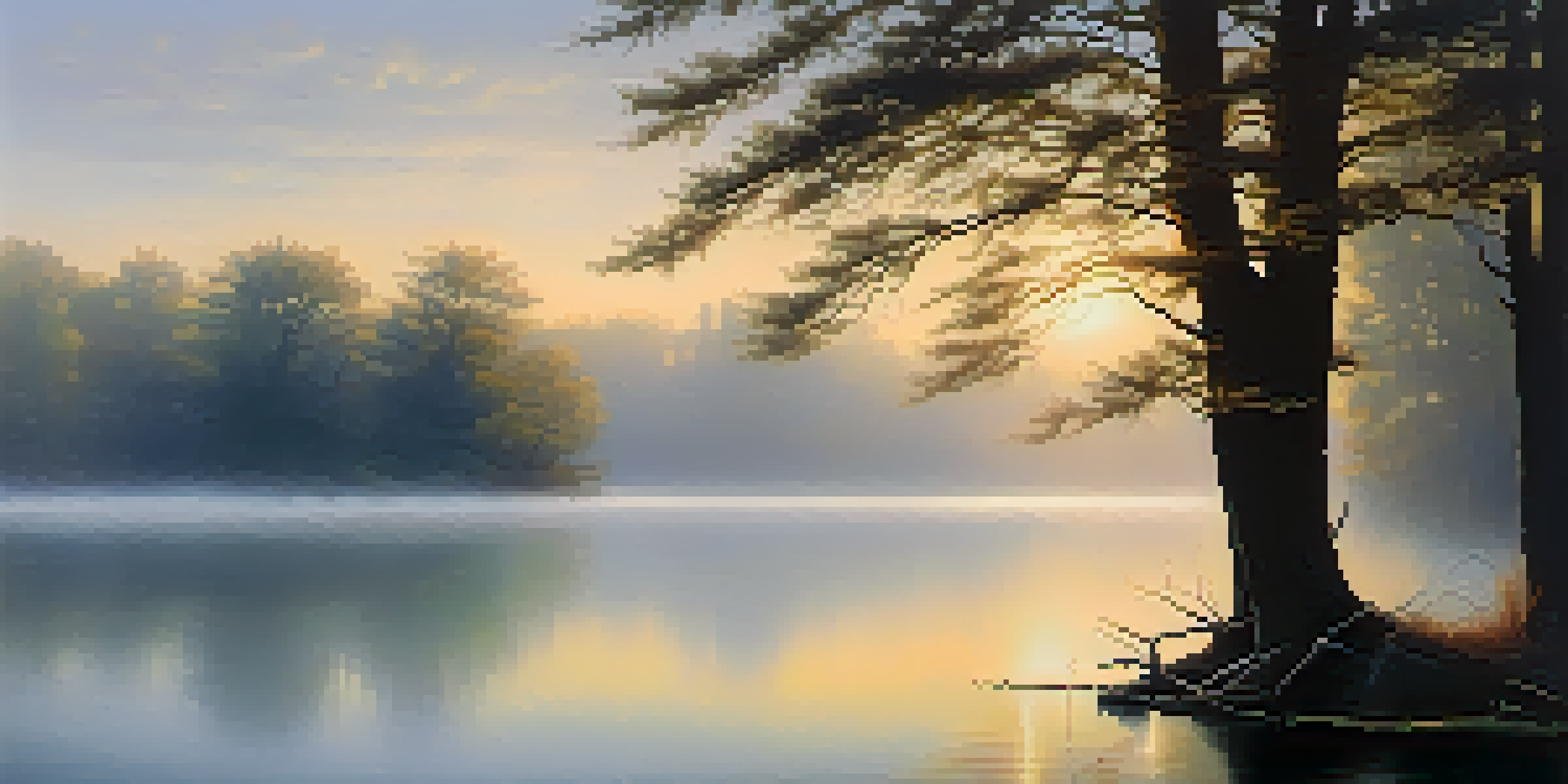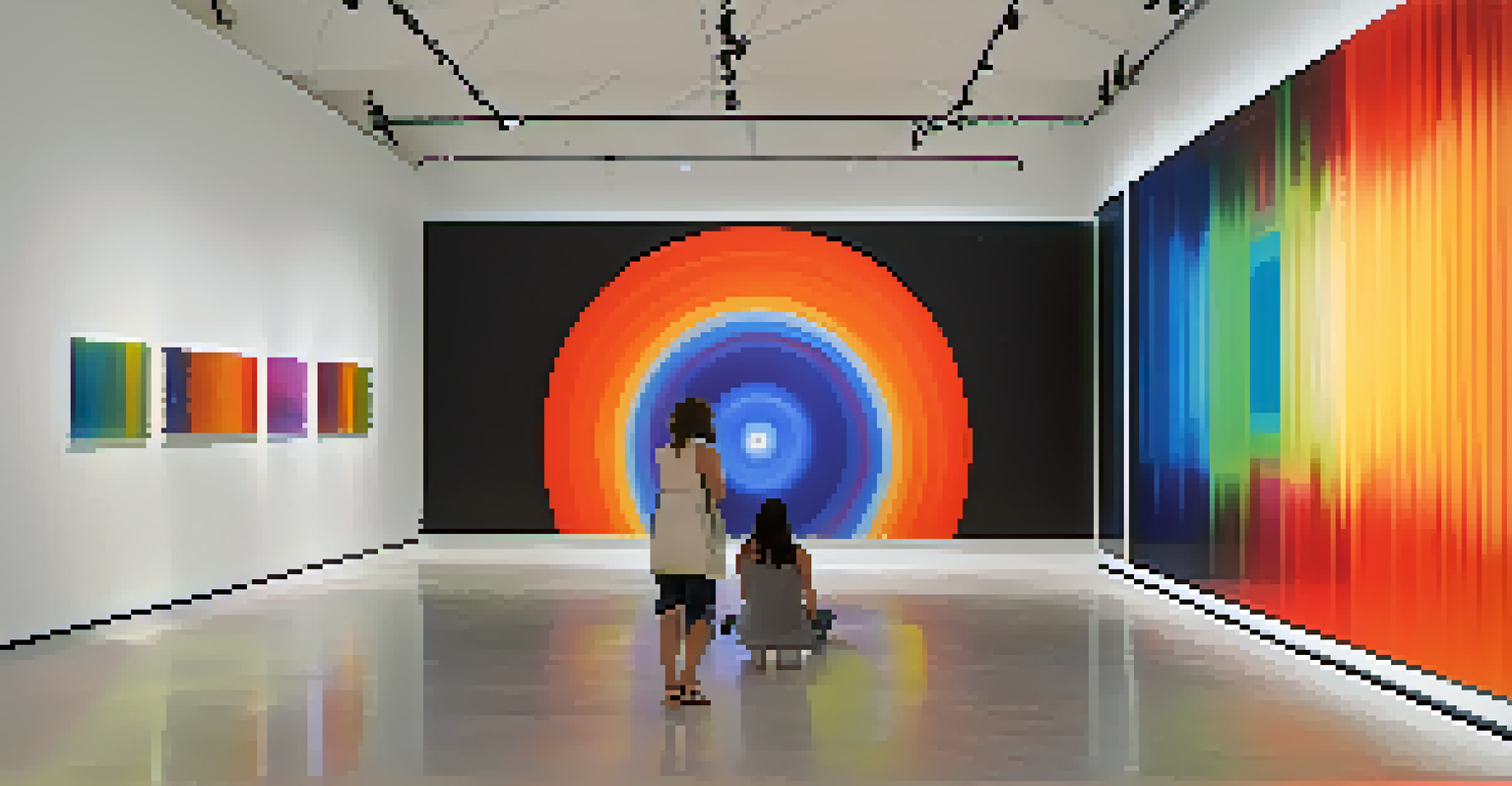The Aesthetics of Noise: Visual Representations of Sound

Understanding the Concept of Sound Aesthetics
Sound aesthetics refers to the beauty and emotional impact of sound. It's not just about what we hear, but how it makes us feel and visualize. For instance, a haunting melody can evoke images of a foggy landscape, while a lively beat might bring to mind a bustling city. This interplay between sound and imagery is at the heart of exploring visual representations of sound.
Sound can be a catalyst for visual art, allowing us to see emotions and experiences in a new light.
When we think of aesthetics, we often picture visual art—paintings, sculptures, or photography. However, sound is an equally powerful medium that can elicit strong visual associations. Imagine listening to a symphony; the crescendos and decrescendos can create vivid pictures in our minds. This phenomenon encourages artists to translate auditory experiences into visual forms.
Ultimately, understanding sound aesthetics is essential for appreciating how artists bridge the gap between auditory and visual worlds. The beauty of sound lies in its ability to inspire creativity and provoke thought, making it a vital aspect of the artistic landscape.
Historical Context: Sound and Visual Art
The relationship between sound and visual art has deep historical roots. For centuries, cultures around the world have sought to represent sound visually, from ancient rituals to modern performances. For example, cave paintings often depicted scenes accompanied by music, illustrating the intrinsic link between these two forms of expression.

In the 20th century, the advent of technology brought new opportunities for artists to explore this relationship. Movements like Futurism celebrated the dynamism of sound, incorporating it into visual works to convey energy and motion. Artists like Wassily Kandinsky believed that colors and shapes could evoke specific sounds, paving the way for a new understanding of synesthesia in art.
Sound and Visual Art Connection
Sound aesthetics bridge the gap between auditory experiences and visual representations, enriching both art forms.
Today, this historical context enriches contemporary practices. Artists continue to draw inspiration from the past while experimenting with innovative methods to represent sound visually, creating immersive experiences that captivate audiences.
Techniques for Visualizing Sound: An Overview
Visualizing sound can take many forms, from traditional art techniques to modern digital methods. One common approach is using sound waves to create visual patterns, such as in spectrograms, which illustrate how different frequencies and amplitudes manifest visually. These images can be stunning, turning invisible sound into tangible artwork.
The interplay between sound and visual art is a rich territory for exploration, inviting us to experience the world through multiple senses.
Another fascinating technique involves the use of software to transform audio into visual representations in real-time. Artists can manipulate sound waves to create mesmerizing visuals that evolve alongside the music, creating a truly immersive experience for the audience. This approach is often seen in live performances where light and sound harmoniously blend.
These techniques not only enhance our understanding of sound but also challenge our perceptions of art. By combining auditory and visual elements, artists encourage viewers to engage with their work on multiple sensory levels, fostering a deeper appreciation for both art forms.
The Role of Technology in Sound Visualization
Technology has revolutionized how we visualize sound, offering artists tools that were previously unimaginable. Digital audio workstations (DAWs) allow for intricate manipulation of sound, and software like Max/MSP or Processing provides platforms for developing complex visualizations. These advancements empower creators to push the boundaries of traditional art forms.
Moreover, advancements in virtual reality (VR) and augmented reality (AR) have opened new doors for sound visualization. Artists can now create interactive environments where sound and visuals coexist, allowing audiences to explore their works in a fully immersive way. Imagine walking through a gallery where sounds guide you to different visual experiences; it’s a compelling blend of art and technology.
Technology Enhances Sound Visualization
Innovative technologies like VR and DAWs empower artists to create immersive experiences that blend sound and visuals.
As technology continues to evolve, so too will the ways we visualize sound. This ongoing dialogue between sound and technology will undoubtedly lead to exciting new artistic expressions that challenge and inspire both artists and audiences alike.
Case Studies: Artists Who Visualize Sound
Numerous artists have made significant contributions to the visual representation of sound. One notable figure is artist Ryoji Ikeda, who creates installations that explore the aesthetics of sound through minimalist visual designs. His works often use data and sound to produce stunning visuals, emphasizing the beauty found in simplicity.
Another influential artist is Janet Cardiff, known for her audio walks that blend narrative soundscapes with specific locations. By guiding viewers through spaces while immersing them in sound, she creates a unique experience that encourages participants to visualize the auditory elements in real-time. This innovative approach merges storytelling with visual art seamlessly.
These case studies demonstrate the diverse ways artists interpret and visualize sound, each bringing their unique perspective to the table. Their contributions highlight the rich potential of sound aesthetics, inspiring others to explore this fascinating intersection of art forms.
The Impact of Sound Visualization on Perception
Sound visualization significantly influences how we perceive both sound and art. By transforming auditory experiences into visual forms, artists can alter our understanding of sound's emotional and aesthetic qualities. For example, a loud, chaotic sound might be represented by vibrant, erratic visuals, emphasizing its intensity and evoking a visceral response.
Additionally, visual representations of sound can bridge cultural gaps, making auditory experiences more accessible to diverse audiences. When sound is represented visually, it transcends language barriers, inviting individuals from various backgrounds to engage with the artwork. This inclusivity enriches the artistic experience and fosters a sense of community among viewers.
Impact on Perception and Inclusivity
Visualizing sound transforms our understanding of auditory experiences, fostering inclusivity and deeper emotional connections.
Ultimately, the impact of sound visualization extends beyond art itself; it shapes how we connect with the world around us. By encouraging us to see sound, artists deepen our appreciation for both forms of expression, enhancing our ability to communicate emotions and experiences.
Future Directions: Evolving Aesthetics of Sound and Visuals
As we look to the future, the aesthetics of sound and its visual representations will undoubtedly continue to evolve. With advances in technology, artists are likely to explore new forms and mediums, merging sound with various art forms in innovative ways. This evolution presents exciting possibilities for creating immersive environments that captivate and engage audiences on multiple sensory levels.
Furthermore, the growing interest in interdisciplinary practices encourages collaboration between sound artists and visual creators. This collaborative spirit can lead to groundbreaking works that challenge traditional boundaries and redefine our understanding of sound and visual art. The fusion of these disciplines promises a rich future for artistic exploration.

In conclusion, the aesthetics of noise and its visual representations will remain a dynamic field ripe for exploration. As artists push the envelope, we can anticipate a vibrant landscape where sound and visuals coexist harmoniously, inviting us to experience art in entirely new ways.